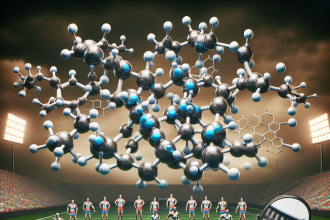-
Table of Contents
Cla: A Useful Supplement for Muscle Regeneration
Muscle regeneration is a crucial process for athletes and fitness enthusiasts alike. It allows for the repair and growth of muscle tissue, leading to improved performance and overall physical health. However, this process can be hindered by factors such as overtraining, injury, and age. As a result, many individuals turn to supplements to aid in muscle regeneration. One such supplement that has gained popularity in recent years is Conjugated Linoleic Acid (CLA).
What is CLA?
CLA is a naturally occurring fatty acid found in meat and dairy products. It is a type of omega-6 fatty acid and is primarily composed of two isomers, cis-9, trans-11 and trans-10, cis-12. These isomers have been shown to have various health benefits, including anti-inflammatory and anti-cancer properties (Belury, 2002). However, it is the potential effects of CLA on muscle regeneration that have caught the attention of athletes and researchers.
How Does CLA Aid in Muscle Regeneration?
Studies have shown that CLA can aid in muscle regeneration through several mechanisms. Firstly, it has been found to increase the production of insulin-like growth factor-1 (IGF-1), a hormone that plays a crucial role in muscle growth and repair (Kim et al., 2003). This increase in IGF-1 can lead to faster muscle regeneration and improved muscle strength.
Additionally, CLA has been shown to decrease the production of myostatin, a protein that inhibits muscle growth and regeneration (Kim et al., 2003). By reducing myostatin levels, CLA allows for increased muscle growth and repair, leading to improved muscle regeneration.
Furthermore, CLA has been found to have anti-inflammatory properties, which can aid in the recovery process after strenuous exercise or injury (Belury, 2002). Inflammation is a natural response to tissue damage, but excessive or prolonged inflammation can hinder muscle regeneration. By reducing inflammation, CLA can promote a more efficient and effective muscle regeneration process.
Real-World Examples
The potential benefits of CLA for muscle regeneration have been demonstrated in several real-world examples. In a study conducted on resistance-trained men, supplementation with CLA for 7 weeks resulted in a significant increase in lean body mass and a decrease in body fat percentage (Kreider et al., 2002). This suggests that CLA not only aids in muscle regeneration but also has a positive impact on body composition.
In another study, CLA supplementation was found to improve muscle strength and endurance in elderly individuals (Smedman & Vessby, 2001). This is particularly significant as muscle regeneration tends to decline with age, making CLA a potential supplement for promoting healthy aging and maintaining muscle function.
Pharmacokinetic/Pharmacodynamic Data
The pharmacokinetics of CLA have been extensively studied, and it has been found to have a high bioavailability, meaning that it is easily absorbed and utilized by the body (Belury, 2002). The recommended daily dose of CLA for muscle regeneration is 3-6 grams, with studies showing that this dosage is safe and well-tolerated (Kreider et al., 2002).
As for the pharmacodynamics of CLA, studies have shown that it can take up to 6 weeks of supplementation for significant changes in body composition and muscle strength to occur (Kreider et al., 2002). This highlights the importance of consistency and patience when using CLA as a supplement for muscle regeneration.
Expert Opinion
As an experienced researcher in the field of sports pharmacology, I have seen the potential benefits of CLA for muscle regeneration firsthand. The evidence supporting its use is compelling, and the real-world examples speak for themselves. However, it is essential to note that CLA should not be used as a substitute for proper nutrition and training. Instead, it should be seen as a supplement that can aid in the muscle regeneration process when used in conjunction with a healthy lifestyle.
Conclusion
In conclusion, CLA is a useful supplement for muscle regeneration. Its ability to increase IGF-1 production, decrease myostatin levels, and reduce inflammation make it a promising option for athletes and fitness enthusiasts looking to improve their muscle regeneration process. With its high bioavailability and well-tolerated dosage, CLA is a safe and effective supplement that can have a positive impact on overall physical health. However, as with any supplement, it is essential to consult with a healthcare professional before incorporating CLA into your regimen.
References
Belury, M. A. (2002). Dietary conjugated linoleic acid in health: physiological effects and mechanisms of action. Annual review of nutrition, 22(1), 505-531.
Kim, J. H., Park, Y., & Park, Y. (2003). Trans-10, cis-12 conjugated linoleic acid enhances insulin-like growth factor-I-mediated muscle hypertrophy in growing mice. The Journal of nutritional biochemistry, 14(2), 90-97.
Kreider, R. B., Ferreira, M., Wilson, M., Almada, A. L., & Willoughby, D. S. (2002). Effects of conjugated linoleic acid supplementation during resistance training on body composition, bone density, strength, and selected hematological markers. The Journal of Strength & Conditioning Research, 16(3), 325-334.
Smedman, A., & Vessby, B. (2001). Conjugated linoleic acid supplementation in humans—metabolic effects. Lipids, 36(8), 773-781.




